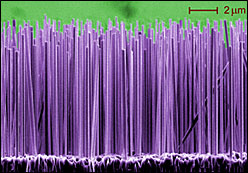GAITHERSBURG, Md., May 30, 2006 -- The nano world is getting brighter, thanks to newly "grown" nanowires made of semiconductor materials that are being used to make prototype lasers and LEDs with emission apertures roughly 100 nanometers in diameter, or about 50 times narrower than their conventional counterparts, and the measurement tools needed to characterize them.
NIST "grows" semiconductor nanowires that emit ultraviolet light as part of a project to make prototype nanolasers and other devices and the measurement tools needed to characterize them. An electron micrograph shows the gallium nitride wires growing on a silicon substrate. The color was added for contrast. (Image: Lorelle Mansfield/NIST)
Researchers at the National Institute of Standards and Technology (NIST) said they are growing nanowires made of gallium nitride alloys and making prototype devices and nanometrology tools. The wires are grown under high vacuum by depositing atoms layer by layer on a silicon crystal. NIST is one of few laboratories capable of growing such semiconductor nanowires without using metal catalysts, the researchers said, an approach believed to enhance luminescence and flexibility in crystal design. The wires are generally between 30 and 500 nm in diameter and up to 12 µm long. When excited with a laser or electric current, the wires emit an intense glow in the ultraviolet or visible parts of the spectrum, depending on the alloy composition.
Nanolight sources may have many applications, they said, including "lab on a chip" devices for identifying chemicals and biological agents, scanning-probe microscope tips for imaging objects smaller than is currently possible, or ultraprecise tools for laser surgery and electronics manufacturing.
A paper in the May 22 issue of Applied Physics Letters reports that individual nanowires grown at NIST produce sufficiently intense light to enable reliable room-temperature measurements of their important characteristics. For example, the peak wavelength of light emitted with electric field parallel to the long axis of a nanowire is shifted with respect to the peak wavelength emitted with electric field perpendicular to the wire. Such differences in emission are used to characterize the nanowire materials and also may be exploited to make sensors and other devices.
NIST researchers said they have grown a variety of nanowires and extensively characterized their structural and optical properties, finding few defects, strains or impurities, which results in high light output compared to the bulk material. The wires also can be transferred from the silicon crystal to other substrates, such as sapphire, and arranged using electric fields. The team has used the nanowires to make a number of prototype devices, including light-emitting diodes, field-effect transistors, and nanowire “bridge” structures that may be useful in sensors and nanoscale mechanical resonators.
For more information, visit: www.nist.gov